Google Inc. (NASDAQ:GOOG) of Mountain View, CA, typically impresses with its technological innovations but a recent financial gain has turned many of Wall Street’s eyes squarely towards this firm. On Friday, July 17th, a 16 percent jump in Google’s public stock sent the company’s market capitalization skyrocketing by $65.1 billion, edging out a previous record for the largest one-day gains in shareholder wealth set by Cisco Systems (NASDAQ:CSCO) in April 2000. This surge came on the heels of the release of Google’s most recent earning report, in which the company noted strong performance from its YouTube division as well as overall profitability. Google has also recently offered some backlash against rules issued by the U.S. Commerce Department which would require the licensing of companies that are exporting intrusion software, hacking software developed by Google to uncover software bugs but which could have international law implications if used by repressive political regimes or cyber criminals.
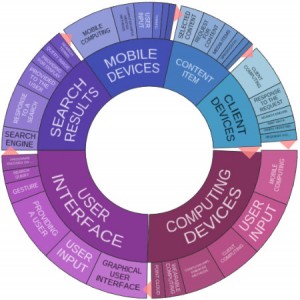 Google is one of the top applicants for patents on new technologies issued by the U.S. Patent and Trademark Office that we follow. In 2014, Google was the recipient of 2,566 patents from the USPTO, the 8th largest amount of patents issued by the office to any single entity that year. In the past three months, the company was assigned 710 U.S. patents, according to data accessed through the patent portfolio analysis tools at Innography. As the text cluster provided here shows us, half of Google’s recent research and development has focused on computing devices and user interfaces, although search engine results are still receiving a fair amount of attention.
Google is one of the top applicants for patents on new technologies issued by the U.S. Patent and Trademark Office that we follow. In 2014, Google was the recipient of 2,566 patents from the USPTO, the 8th largest amount of patents issued by the office to any single entity that year. In the past three months, the company was assigned 710 U.S. patents, according to data accessed through the patent portfolio analysis tools at Innography. As the text cluster provided here shows us, half of Google’s recent research and development has focused on computing devices and user interfaces, although search engine results are still receiving a fair amount of attention.
Google inhabits a very powerful position in information technology industries. The company is a technological leader some important sectors of the smartphone sector including digital wallets, which it strengthened recently by acquiring Softcard in February of this year. Google’s R&D extends into a myriad of futuristic tech concepts, from robots with personality to drones designed for medical emergency response. We’ve also covered an unusual dichotomy in Google’s stance towards the U.S. patent system. Google’s activities in this field are important because of the large size of both the company and its patent portfolio, half of which is made up of software technologies.
[Companies-1]
Issued Patents of Note: Autonomous Vehicles and Social Studying
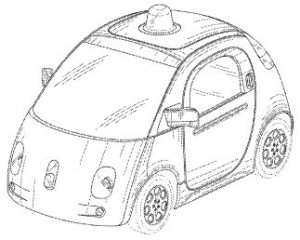 We don’t normally profile design patents but we came across a couple which highlight Google’s involvement in vehicle development, especially for the autonomous vehicle which has been an area of innovation that has seen a lot of activity this year. U.S. Patent No. D734211, which is titled Autonomous Vehicle Exterior, protects the design of a compact car which somewhat resembles a Volkswagen Beetle with a nub that sticks out of the top of the vehicle which could perhaps contain digital communications equipment. More vehicle
We don’t normally profile design patents but we came across a couple which highlight Google’s involvement in vehicle development, especially for the autonomous vehicle which has been an area of innovation that has seen a lot of activity this year. U.S. Patent No. D734211, which is titled Autonomous Vehicle Exterior, protects the design of a compact car which somewhat resembles a Volkswagen Beetle with a nub that sticks out of the top of the vehicle which could perhaps contain digital communications equipment. More vehicle 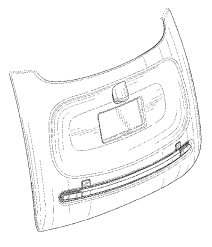 design research can be seen reflected within U.S. Patent No. D733630, issued under the title Vehicle Rear Door. The rear door design reflected here has a slight curvature, a long member running along the bottom of the door which could be a handle and a small opening for a window.
design research can be seen reflected within U.S. Patent No. D733630, issued under the title Vehicle Rear Door. The rear door design reflected here has a slight curvature, a long member running along the bottom of the door which could be a handle and a small opening for a window.
Self-driving cars were also the focus of a couple of utility patents we discovered during our most recent survey of Google’s technological innovations. A system for switching a vehicle in and out of a self-driving mode more easily is at the center of U.S. Patent No. 9075413, titled Engaging and Disengaging for Autonomous Driving. The patent protects a method of receiving a request to switch a vehicle from a manual driving mode to an autonomous driving mode, determining if the vehicle’s location is within a preapproved area or lane for autonomous driving and generating a set of tasks that a driver must complete, if necessary, before a car can enter an autonomous mode. This system is designed to provide a layer of protection to a driver by ensuring that the switch from manual to autonomous driving wouldn’t be detrimental to the driver’s safety. More accurate computer systems for controlling a car’s 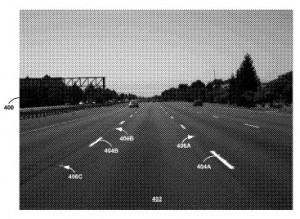 movement are discussed within U.S. Patent No. 9081385, which is titled Lane Boundary Detection Using Images. This patent discloses a method of receiving an image of a vehicle’s road of travel, determining whether pixels in certain regions of the image meet a certain threshold of intensity and using the pixel information to determine the location of driving lanes on the road. The lane information is then analyzed to control the vehicle and ensure it stays within its proper driving lane.
movement are discussed within U.S. Patent No. 9081385, which is titled Lane Boundary Detection Using Images. This patent discloses a method of receiving an image of a vehicle’s road of travel, determining whether pixels in certain regions of the image meet a certain threshold of intensity and using the pixel information to determine the location of driving lanes on the road. The lane information is then analyzed to control the vehicle and ensure it stays within its proper driving lane.
Google Glass may not be the smash hit in the wearable sector that was hoped for but the company is still pushing ahead with developments for this tech. U.S. Patent No. 9057826, titled See-Through Near-to-Eye Display with Eye Prescription, protects an optical apparatus for a head mounted display which includes an optical combiner having an eye-ward sign and an external scene side; the optical combiner creates a combined image using image light and scene light and correcting the image according to first and second corrective prescriptions. This technology is intended to provide users of near-to-eye displays with a function for corrective vision if they don’t wish to wear contacts or additional eyeglasses.
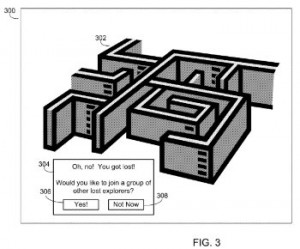 Enhancements to digital gameplay among a multitude of participants are the focus of U.S. Patent No. 9075761, titled Social Spaces for Games. The computer-implemented method protected by this patent involves identifying a plurality of individuals who have participated in an electronic game, identifying a social networking group associated with participation in the electronic game, associating the social networking group with the plurality of players, identifying players in the group who have completed a certain action within a game or those attempting the action to segregate communications into those two groups. The system could help those trying to beat a tough challenge to do so collaboratively with other players or simply connect users who have a social affinity.
Enhancements to digital gameplay among a multitude of participants are the focus of U.S. Patent No. 9075761, titled Social Spaces for Games. The computer-implemented method protected by this patent involves identifying a plurality of individuals who have participated in an electronic game, identifying a social networking group associated with participation in the electronic game, associating the social networking group with the plurality of players, identifying players in the group who have completed a certain action within a game or those attempting the action to segregate communications into those two groups. The system could help those trying to beat a tough challenge to do so collaboratively with other players or simply connect users who have a social affinity.
Collaborative technologies for more effective study are another focal area for Google’s R&D, as is evidenced by U.S. Patent No. 9063641, titled Systems and Methods for Remote Collaborative Studying Using Electronic Books. The electronic book reader protected here includes an input recognition subsystem, operably connected to an annotation subsystem, which generates a message in response to an annotation including the portion of a textbook which was being read; the message is sent to a predetermined moderator for the textbook. This system could enable students to compare notes on textbook readings and form small study groups on lecture material.
[Companies-2]
Google’s Patent Applications: More Vehicle Tech and Personalized News Media
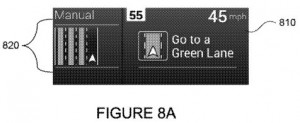 Self-driving vehicles will continue to be a major area of activity for Google as we’ve noticed a number of patent applications which reflect ongoing R&D in this sector. A technology designed to give an autonomous car’s driver better information regarding when the vehicle may be put into a self-driving mode is described within U.S. Patent Application No. 20150192428, titled Determining and Displaying Auto Drive Lanes in an Autonomous Vehicle. The patent application would protect a computer-implemented method that involves accessing detailed map information identifying the locations of autodrive lanes preapproved for a vehicle’s autonomous driving mode, identifying at least two autodrive lanes and generating display information identifying the autodrive lanes. This technology is designed to give the operator of an autonomous vehicle more information about driving conditions, including how the remaining distance until a car must be taken out of an autonomous driving mode. A system for reporting fuel efficient driving techniques to a driver is reflected within U.S. Patent Application No. 20150183439, titled Systems and Methods for Monitoring and Reporting Vehicle Efficiency. The method for generating a route for navigating a vehicle that would be protected involves obtaining indications of a route traveled, fuel efficiency on that route and an expected fuel efficiency, and then generating a navigation route which consumes the least amount of fuel. This technology is capable of providing better results on fuel efficient routes by incorporating data aggregation from multiple vehicles.
Self-driving vehicles will continue to be a major area of activity for Google as we’ve noticed a number of patent applications which reflect ongoing R&D in this sector. A technology designed to give an autonomous car’s driver better information regarding when the vehicle may be put into a self-driving mode is described within U.S. Patent Application No. 20150192428, titled Determining and Displaying Auto Drive Lanes in an Autonomous Vehicle. The patent application would protect a computer-implemented method that involves accessing detailed map information identifying the locations of autodrive lanes preapproved for a vehicle’s autonomous driving mode, identifying at least two autodrive lanes and generating display information identifying the autodrive lanes. This technology is designed to give the operator of an autonomous vehicle more information about driving conditions, including how the remaining distance until a car must be taken out of an autonomous driving mode. A system for reporting fuel efficient driving techniques to a driver is reflected within U.S. Patent Application No. 20150183439, titled Systems and Methods for Monitoring and Reporting Vehicle Efficiency. The method for generating a route for navigating a vehicle that would be protected involves obtaining indications of a route traveled, fuel efficiency on that route and an expected fuel efficiency, and then generating a navigation route which consumes the least amount of fuel. This technology is capable of providing better results on fuel efficient routes by incorporating data aggregation from multiple vehicles.
Many people go to Google in order to find the media and news content which they seek and the company is devising ways of making that even simpler for Internet browsers. U.S. Patent Application No. 20150186532, filed under the title Generating a News Timeline, would protect a method for displaying news content to a user by annotating news content items with topics and dates, recording a count of how many times a news content item is viewed, identifying profile information for a user and identifying a plurality of news content items to be recommended to a user. This technology is designed to improve upon conventional news aggregators by taking the historical context of an article into better account. The automatic generation of a personal digital publication containing various  articles of interest is at the center of U.S. Patent Application No. 20150186491, filed under the title Personalized Electronic Magazine. The patent application would protect an electronic magazine system that has an indexing module which establishes correspondence between content items and available topics, a user profile manager that determines interests of a user and a user recommendation generator coupled to the indexing module and the user profile manager and configured to select magazine items responsive to the correspondence. This innovation is designed to determine content of interest to a specific reader and providing that material in such a way that enables efficient access for that reader. The better absorption of reading material provided by eBooks is also a focal area for Google R&D as can be seen within U.S. Patent Application No. 20150187225, titled Providing Quizzes in Electronic Books to Measure and Improve Reading Comprehension. This patent application would protect a computer-implemented method for inserting question material into an electronic book by establishing a quiz corresponding to a section of the eBook and responsive to information received from an educator client device, receiving clues to assist learners in responding to quiz questions and receiving learner responses to the questions. This invention intends to further realize the effect of digital technologies on reading-based education by providing both readers and teachers with tools for improving reading comprehension.
articles of interest is at the center of U.S. Patent Application No. 20150186491, filed under the title Personalized Electronic Magazine. The patent application would protect an electronic magazine system that has an indexing module which establishes correspondence between content items and available topics, a user profile manager that determines interests of a user and a user recommendation generator coupled to the indexing module and the user profile manager and configured to select magazine items responsive to the correspondence. This innovation is designed to determine content of interest to a specific reader and providing that material in such a way that enables efficient access for that reader. The better absorption of reading material provided by eBooks is also a focal area for Google R&D as can be seen within U.S. Patent Application No. 20150187225, titled Providing Quizzes in Electronic Books to Measure and Improve Reading Comprehension. This patent application would protect a computer-implemented method for inserting question material into an electronic book by establishing a quiz corresponding to a section of the eBook and responsive to information received from an educator client device, receiving clues to assist learners in responding to quiz questions and receiving learner responses to the questions. This invention intends to further realize the effect of digital technologies on reading-based education by providing both readers and teachers with tools for improving reading comprehension.
Google earns a great deal of its revenue from advertisements so its not surprising that we would see innovation from the company in this area, such as is the case with U.S. Patent Application No. 20150193811, titled System and Method for Estimating Potential Unique Online Users an Advertisement Can Reach. The computer-implemented method that would be protected by this patent application involves receiving a keyword, web page and advertisement criteria comprising a bid, determining a number of users who are candidates for advertisement display and providing a report of the number of users who have not yet received an advertisement. This technology can improve a business’s budgeting for online advertisement campaigns.
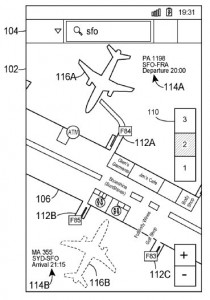 Finally, we’ll close our coverage of Google innovation with a look at one system which seeks to give those relying on air travel a better sense of when they can expect to depart. U.S. Patent Application No. 20150187232, titled System and Method for Displaying Real-Time Flight Information on an Airport Map, would protect a method for displaying real-time flight information on a user interface of a client device by displaying a digital map of an airport, receiving real-time information of an airplane departing from or arriving at the airport, determining a baggage claim area associated with the flight information and displaying the information on a location of the map. This invention is also designed to help airport visitors determine with greater accuracy the time at which an aircraft will either embark from an airport or arrive on the runway.
Finally, we’ll close our coverage of Google innovation with a look at one system which seeks to give those relying on air travel a better sense of when they can expect to depart. U.S. Patent Application No. 20150187232, titled System and Method for Displaying Real-Time Flight Information on an Airport Map, would protect a method for displaying real-time flight information on a user interface of a client device by displaying a digital map of an airport, receiving real-time information of an airplane departing from or arriving at the airport, determining a baggage claim area associated with the flight information and displaying the information on a location of the map. This invention is also designed to help airport visitors determine with greater accuracy the time at which an aircraft will either embark from an airport or arrive on the runway.

![[IPWatchdog Logo]](https://ipwatchdog.com/wp-content/themes/IPWatchdog%20-%202023/assets/images/temp/logo-small@2x.png)

![[Advertisement]](https://ipwatchdog.com/wp-content/uploads/2024/04/UnitedLex-May-2-2024-sidebar-700x500-1.jpg)
![[Advertisement]](https://ipwatchdog.com/wp-content/uploads/2024/04/Artificial-Intelligence-2024-REPLAY-sidebar-700x500-corrected.jpg)
![[Advertisement]](https://ipwatchdog.com/wp-content/uploads/2024/04/Patent-Litigation-Masters-2024-sidebar-700x500-1.jpg)

![[Advertisement]](https://ipwatchdog.com/wp-content/uploads/2021/12/WEBINAR-336-x-280-px.png)
![[Advertisement]](https://ipwatchdog.com/wp-content/uploads/2021/12/2021-Patent-Practice-on-Demand-recorded-Feb-2021-336-x-280.jpg)
![[Advertisement]](https://ipwatchdog.com/wp-content/uploads/2021/12/Ad-4-The-Invent-Patent-System™.png)






Join the Discussion
2 comments so far.
Anon
July 30, 2015 06:23 amBenny,
There is an obvious an immediate difference between the “any malfunction” of an airliner and of a car (one joke that comes to mind is that it is not the fall that kills you, but the sudden stop at the end of the fall).
Like it or not, we as a society have already discounted the “death” factor related to the “malfunctions” of automobiles. While indeed at recent historic lows (compared to overall population), we seem quite content with over 30,000 deaths per year.
Airline deaths: less than a thousand, worldwide
Gun deaths: 11,000
You cannot remove the emotive factor that attaches itself. Here in the US, the car as the symbol of individual freedom is a cultural artifact that increases our acceptance of death as a result of our choice and plays a stronger role than even the fear of death itself.
Benny
July 30, 2015 05:39 amI may be proved wrong, but I have a feeling that the same legal mindset which created the general aviation crisis in the 80’s, (where manufacturers were held financially liable to the tune of their overall profits for the consequences of virtually any malfunction), will prevent the acceptance of autonomous vehicles on our roads.